| Colonialism and Liberation in the Andes
Vasco Nuñez de Balboa led the first European expedition to the Pacific coast of the Americas in 1513. He had been informed by Panamanian isthmus natives of a rich kingdom where they drank and ate from vessels of gold. Similar stories reached the Portuguese on the southeast coast of South America. The first European to enter the Inca realm was Portuguese Alejo Garcia. He entered from Paraguay in the company of five Cairo Indians. Alejo was killed by Tupi Indians and his Cairo companions returned to the coast with some gold and silver. In 1526 Sebastian Cabot, following this information, attempted to reach Perú from the Argentine coast. For a full century after the Inca conquest from the Pacific the search for the fabled El Dorado was still pursued from the Atlantic.
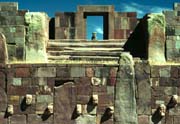 It was in 1531 that Spaniard Francisco Pizarro (a member of Nuñez de Balboa's expedition) invaded the Quechua region. Pizarro and a small army succeeded in subjugating the Incas in 1533. Forty years later the last resistance by the Incas had been crushed. (Discussed in detail in the Tupac Amaru page of this web ring.) It was in 1531 that Spaniard Francisco Pizarro (a member of Nuñez de Balboa's expedition) invaded the Quechua region. Pizarro and a small army succeeded in subjugating the Incas in 1533. Forty years later the last resistance by the Incas had been crushed. (Discussed in detail in the Tupac Amaru page of this web ring.)
Recent demographic studies have the Indigenous American population at between 70 to 100 million people at time of contact, with estimates of some 50 to 70 million in South America. During a 100 year period, the populations of the Indigenous peoples declined from a possible 100 million to around 12 million. In Mexico, the population was reduced from perhaps 30 million to 3 million in just 50 years. Millions of Indigenous peoples died working as slaves in the mines at Guanajuato and Zacatecas in Mexico, and Potosí in Bolivia.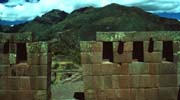 Eight million slaves died in the Potosí mine alone. By the end of the 1500's, Potosí was one of the largest cities in the world with 350,000 inhabitants. Perú was also an area of intensive mining. From the time of the arrival of the first European colonizers until 1650, 180-200 tons of American gold was added to the European treasury. Eight million slaves died in the Potosí mine alone. By the end of the 1500's, Potosí was one of the largest cities in the world with 350,000 inhabitants. Perú was also an area of intensive mining. From the time of the arrival of the first European colonizers until 1650, 180-200 tons of American gold was added to the European treasury.
With the Spanish conquest Quechua society was drastically altered. The Inca system of government required a mit'a tax--the donation of labor to the state to produce crops and public works--and a tax of a portion of production. The mit'a tax was used in part to build terraces and irrigation systems, which further elevated production to the benefit of the society. In contrast, the Spanish encomienda system of tribute required the subjugated Indians to produce unfamiliar crops for the Spanish, at the expense of their own food supply. The Spanish system, unlike its Incan predecessor, did not provide for the welfare of the laborer and his family during the term of forced labor.
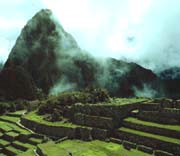 The Spanish also forcibly concentrated the people in villages and assumed right of ownership of the best lands. The Roman Catholic Church made additional demands on the native inhabitants. When Spanish rule ended a large portion of the population had been reduced to chattel servitude on large haciendas and estates. This condition of virtual slavery continued until late in the present century. The Spanish also forcibly concentrated the people in villages and assumed right of ownership of the best lands. The Roman Catholic Church made additional demands on the native inhabitants. When Spanish rule ended a large portion of the population had been reduced to chattel servitude on large haciendas and estates. This condition of virtual slavery continued until late in the present century.
Most regions under Spanish dominion were conquered. There are few exceptions. One example is the Koogi region of Colombia, today considered to be the last surviving remnant of pre-Hispanic civilization in South America. In 1742, Juan Santos Atahualpa led a successful Indigenous resistance effort to Spanish intrusion into the Campa and Amuesha territory of the Peruvian Amazon Basin region. The Amuesha and Campa tribes fought Spanish intrusion for more than a century. Their territories in Central Perú remained unpenetrated by Europeans until the rubber boom of this century, and part of the Campa territory, the Gran Pajonal, remains off-limits to outsiders.
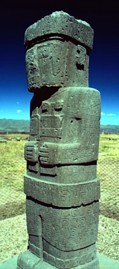 Tribute, tax laws and the oppression of colonialism provoked protest and opposition. In 1780 Indigenous resistance broke out in a major revolt in Bolivia. Chayanta and Sikasika revolts occurred at the same time, the latter led by Tupac Catari. In mid-1780, another revolt, to free Indian leader Tomñs Catari, broke out in the province of Chayanta. On November 4, 1780 José Gabriel Condorcanki Tupac Amaru, great-grandson of the last Inca, launched a well-organized rebellion in the Cuzco area. Condorcanki, better known as Tupac Amaru II, arrested Spanish corregidor Antonio Juan de Arriaga and ordered his execution the following week. On November 16 Tupac Amaru II signed a Proclamation of Liberty, the first anti-slavery edict in Perú. The manifesto declared all slaves to be free. Tribute, tax laws and the oppression of colonialism provoked protest and opposition. In 1780 Indigenous resistance broke out in a major revolt in Bolivia. Chayanta and Sikasika revolts occurred at the same time, the latter led by Tupac Catari. In mid-1780, another revolt, to free Indian leader Tomñs Catari, broke out in the province of Chayanta. On November 4, 1780 José Gabriel Condorcanki Tupac Amaru, great-grandson of the last Inca, launched a well-organized rebellion in the Cuzco area. Condorcanki, better known as Tupac Amaru II, arrested Spanish corregidor Antonio Juan de Arriaga and ordered his execution the following week. On November 16 Tupac Amaru II signed a Proclamation of Liberty, the first anti-slavery edict in Perú. The manifesto declared all slaves to be free.
Tupac Catari led the rebellion that laid siege to La Paz in March of 1781, during which one fourth of the city's population died. In April of 1781 Tupac Amaru II was betrayed and captured. On May 18, after witnessing the execution of his wife and sons, he was mutilated, drawn and quartered, and then beheaded in the plaza in Cuzco. Other captured rebellion leaders were also executed. The leadership of the uprising shifted to Azangaro, Puno, where Tupac's relatives Andres and Diego Cristobal Tupac Amaru continued the struggle. They successfully laid siege to Sorata in August and the rebellion spread as far south as Argentina. By November they were forced to surrender to the Spanish authorities. Diego Cristobal Tupac Amaru was tortured to death in the Cuzco plaza in July of 1783.
The wave of rebellion had been defeated. The leaders, perceived or real, were captured and executed. Many were drawn and quartered, decapitated, or burned alive. Many living descendants of the Incas were rounded up and exiled. Many of these eventually died in prison in Spain. The atrocities of the victors strengthened opposition to Spanish colonialism.
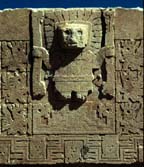 The first major revolt to overthrow Spanish authority was in 1809 in Bolivia. In 1810 Colombia declared its independence, followed by Venezuela the following year. Argentina declared independence in 1816. In 1817 José de San Martín led troops across the Andes to help liberate Chilé and Perú. Spanish forces lost one colony after another. The Battle of Ayacucho, Perú, in 1824 effectively terminated Spain's domination in South America. The first major revolt to overthrow Spanish authority was in 1809 in Bolivia. In 1810 Colombia declared its independence, followed by Venezuela the following year. Argentina declared independence in 1816. In 1817 José de San Martín led troops across the Andes to help liberate Chilé and Perú. Spanish forces lost one colony after another. The Battle of Ayacucho, Perú, in 1824 effectively terminated Spain's domination in South America.
The end of colonialism did not represent an end to the oppression of the native Andean peoples. Power shifted to descendants of the Spaniards, the criollos, and to mixed-race descendants of the Spaniards, the mestizos. Only in recent decades has land reform in Perú and Bolivia effectively ended chattelism. Prejudices and class division along racial/ethnic lines continues to this day in the modern Andean nations. The native peoples remain the under-privileged class and insurrection and rebellion are an ongoing aspect of life in Perú today.
Tupac Amaru was a symbol employed by the military junta in Perú in conjunction with the land reform decree of 1969. The Tupac Amaru revolutionary movement is one of several attempting to overthrow the government in Perú today. Almost two centuries after liberation from Spanish rule, the effects of conquest and colonialism remain apparent in contemporary Andean society. Equality and its consort, peace, have
yet to be attained.
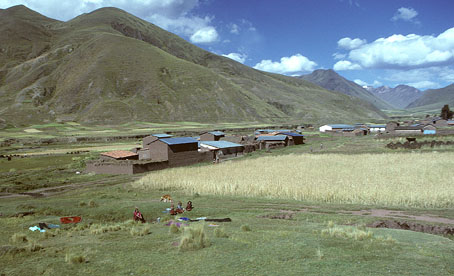
See Bibliography Page for sources. Other Andes academic papers:
TUPAC AMARU, THE LIFE, TIMES, AND EXECUTION OF THE LAST INCA EARLY MONUMENTAL ARCHITECTURE OF THE PERUVIAN COAST CHAVIN AND THE ORIGINS OF ANDEAN CIVILIZATION |